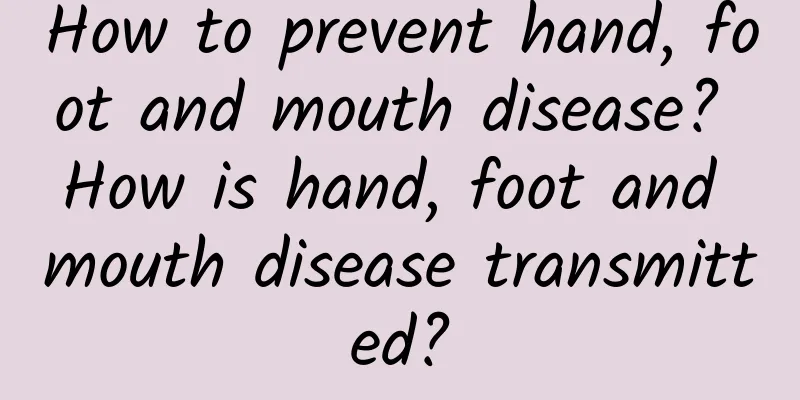How many people can hand, foot and mouth disease infect?

|
How many people can hand, foot and mouth disease infect? Nowadays, there are more and more types of infectious diseases. Many people are infected with infectious diseases accidentally. Hand, foot and mouth disease is a very common infectious disease. It is an infectious disease caused by enterovirus. It has an acute onset, fever, mouth pain, anorexia, and scattered herpes or ulcers on the oral mucosa. It is very harmful to patients. So, how many people can hand, foot and mouth disease infect? Susceptible population People are generally susceptible to the enterovirus that causes hand, foot and mouth disease. After being infected, they can gain immunity. All age groups can be infected and fall ill, but the ratio of latent infection to overt infection is 100:1. Most adults have acquired corresponding antibodies through latent infection. Therefore, patients with hand, foot and mouth disease are mainly preschool children, especially those aged ≤3 years old, with 85% to 95% of the cases within 4 years old. According to foreign observation reports, among the population, an epidemic occurs every 2 to 3 years, mainly due to the birth of newborns during the non-epidemic period. Susceptible people gradually accumulate, and when a certain number is reached, it provides the prerequisite for a new epidemic. Mode of transmission Hand, foot and mouth disease is mainly spread through close contact between people. The virus in the patient's throat secretions and saliva can be spread through air droplets. Saliva, herpes fluid, feces-contaminated hands, towels, handkerchiefs, tooth cups, toys, eating utensils, milk utensils, bedding, underwear, etc. are spread through daily contact, and can also be spread orally. Contact with water contaminated by the virus can also cause oral infection and often cause epidemics. Cross-infection in outpatient clinics and poor disinfection of oral instruments can also cause transmission. Hand, foot and mouth disease is extremely widespread and has no strict regional distribution. It can occur in all seasons, but is more common in summer and autumn, and is relatively rare in winter. The disease often occurs sporadically after an outbreak. During the epidemic, kindergartens and nurseries are prone to collective infection. This kind of outbreak cluster phenomenon also occurs in families. Cross-infection in hospital outpatient clinics and lax disinfection of oral instruments can also cause transmission. Tianjin City had two major outbreaks, and the incidence rate of children in childcare units was significantly higher than that of scattered children. Sporadic cases in families often occur in one family; outbreaks in families occur in multiple people in a family or children and adults are all infected and develop the disease. The disease is highly contagious, with complex transmission routes, high epidemic intensity, and rapid transmission, and can cause a pandemic in a short period of time. There are many ways for hand, foot and mouth disease to spread, and infants and children are generally susceptible. Proper hygiene of children, families and childcare institutions is the key to preventing infection with this disease. |
<<: What should I do if patients with hand, foot and mouth disease always sweat?
>>: Can hand, foot and mouth disease be transmitted to pregnant women?
Recommend
What are the typical symptoms of neonatal kernicterus?
What are the typical symptoms of neonatal kernict...
Diagnostic measures for ADHD in children
Attention Deficit Hyperactivity Disorder (ADHD) i...
How long does it take to cure pneumonia in children?
If pneumonia is not treated, there will be many s...
Can I pinch the Renzhong point when a child has convulsions?
Pinching the Ren Zhong point during a child's...
Symptoms of diarrhea in children
Diarrhea is a very common disease. Although diarr...
Effective folk remedy for the treatment of acute non-icteric hepatitis B
Effective folk remedy for the treatment of acute ...
Are there risks in minimally invasive hernia surgery for children?
The overall risk of minimally invasive surgery fo...
Is 13.5 jaundice on 14 days considered high?
Jaundice is more common in the neonatal period. J...
How to prevent and treat acute laryngitis in children
How to prevent and treat acute laryngitis in chil...
What is the standard jaundice value? How long does it take for neonatal jaundice to appear?
Medically, jaundice in babies under one month old...
What are the symptoms of mycoplasma infection in children?
The most common symptom of mycoplasma infection i...
How to treat a baby's cough with phlegm How to treat a baby's cough with phlegm
Taking care of children is an important task for ...
What foods can't the mother eat after the baby has eczema? Four types of food that the mother is forbidden to eat
During the period of eczema in infants, breastfee...
What are the common tests for Kawasaki disease?
Regarding Kawasaki disease, there is a question t...
Why should children with pneumonia receive intravenous infusion?
Regarding pneumonia, many mothers still think it ...









